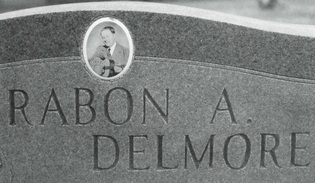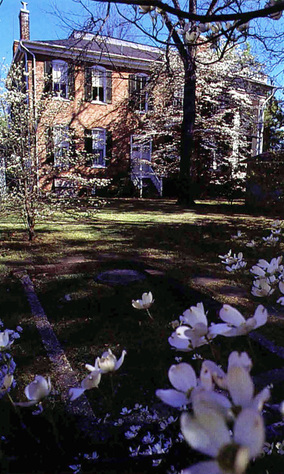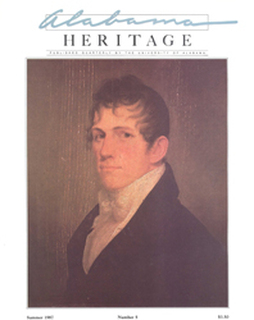|
On the cover: Jack Shackelford of Courtland, Alabama, who lived to tell the story of the Courtland Red Rovers massacred at Goliad, Texas, in 1836. (Courtesy Fred L. Harris)
|
FEATURE ABSTRACTS
Remember Goliad!
By James E. Harris
Following Mexico's independence from Spain in 1821, many Americans moved to Mexico's northernmost state, Texas, lured by economic opportunities and the promise of an unfettered life supposedly guaranteed by Mexico's new constitution. At first, these Americans were welcome. But with the rise of Gen. Antonio López de Santa Anna in 1835, Texans began to grow dissatisfied. Caught up in this turmoil was Jack Shackelford, a forty-five-year-old physician from Courtland. Inexorably, he was drawn into a conflict that would lead ultimately to a terrible massacre. Over 350 Americans would die--prisoners, killed by their captors. The date: March 27, 1836. The place: Goliad.
Additional Information
About the Author
Jim Harris, a graduate student in historic preservation and records management at Colorado State University, is the great-great-great-great-grandson of Jack Shackelford, who organized and led the Red Rovers. From the Shackelford family, Harris has inherited some 450 letters dating from 1809 to the 1870s, many of which he used in preparing this article. Harris' grandmother, Mrs. Katie Louise French Harris, "who saved everything she could related to the family," died in Birmingham on February 25, 1987. "Without her desire to preserve the history of the family," Harris writes, "I'm sure all of the letters that are in my possession would have been lost over the years. I'm saddened that she did not live to see the first article her grandson wrote about the family that she loved so dearly.''
Harris and the editors would also like to thank Kevin Young, curator of the Presidio La Bahia, Goliad, for his assistance in the preparation of this article.
By James E. Harris
Following Mexico's independence from Spain in 1821, many Americans moved to Mexico's northernmost state, Texas, lured by economic opportunities and the promise of an unfettered life supposedly guaranteed by Mexico's new constitution. At first, these Americans were welcome. But with the rise of Gen. Antonio López de Santa Anna in 1835, Texans began to grow dissatisfied. Caught up in this turmoil was Jack Shackelford, a forty-five-year-old physician from Courtland. Inexorably, he was drawn into a conflict that would lead ultimately to a terrible massacre. Over 350 Americans would die--prisoners, killed by their captors. The date: March 27, 1836. The place: Goliad.
Additional Information
- Barnard, Joseph H. Journal, edited and annotated by Hobart Huson (privately printed, 1950).
- Binkley, William C. The Texas Revolution (State University Press, 1952).
- Davenport, Harbert "The Men of Goliad," Southwestern Historical Quarterly 48 (July 1939): 1-41.
- Farmer, Garland R. "Bold Band of State Fighters Died to Aid Texas," Birmingham Age-Herald, November 12, 1939.
- Holland, Benjamin H. Account in Huntsville Democrat, May 31, 1836.
- O'Conner, Kathryn Stoner. Presidio La Bahia, 1721-1846 (Von Boeckmann-Janes Company, 1966).
- Peña, José Enrique de Ia. With Santa Anna in Texas: A Personal Narrative of the Revolution, translated and edited by Carmen Perry (Texas A & M University Press, 1975).
- Santos, Richard G. Santa Anna's Campaign Against Texas, 1835-1836 (Texian Press, 1968).
- Shackelford, Jack. Letters, Alabama Department of Archives and History, Montgomery.
- _____. "Some Few Notes upon a Part of the Texan War," in Texas and the Texans, vol. 2, by Henry Stuart Foote (Thomas Cowperthwait & Co ., 1841), pp. 227-248.
- Yoakum, Henderson. History of Texas from Its First Settlement in 1685 to Its Annexation to the United States in 1846, 2 vols. (Redfield, 1855).
About the Author
Jim Harris, a graduate student in historic preservation and records management at Colorado State University, is the great-great-great-great-grandson of Jack Shackelford, who organized and led the Red Rovers. From the Shackelford family, Harris has inherited some 450 letters dating from 1809 to the 1870s, many of which he used in preparing this article. Harris' grandmother, Mrs. Katie Louise French Harris, "who saved everything she could related to the family," died in Birmingham on February 25, 1987. "Without her desire to preserve the history of the family," Harris writes, "I'm sure all of the letters that are in my possession would have been lost over the years. I'm saddened that she did not live to see the first article her grandson wrote about the family that she loved so dearly.''
Harris and the editors would also like to thank Kevin Young, curator of the Presidio La Bahia, Goliad, for his assistance in the preparation of this article.
 In his tombstone photograph, Rabon Delmore sings
In his tombstone photograph, Rabon Delmore sings into a microphone emblazoned with the station
call letters "G-O-D." He is buried in
Athens, Alabama. (Photo courtesy Lynn Pruett)
The Delmore Brothers
By Lynn Pruett
Although bad luck and hard times seemed to be the chorus that followed performer brothers Alton and Rabon Delmore throughout their joint music career, the Delmore brothers profoundly influenced the country music of their day. Their works became mainstays, but they never struck it rich. This article recounts the story of these brothers, from their early experiences in Elkmont, Alabama, through World War II, to Alton's death in 1964.They came along thirty years before country music transformed into a money-making phenomenon, but their influence on the genre has secured their place in music history.
Additional Information
About the Author
Lynn Pruett, a native of Nashville, Tennessee, is a candidate for a master of fine arts degree in creative writing at the University of Alabama. In 1982 Pruett graduated from Mount Holyoke College, where she majored in American Studies and wrote an honors thesis on the commercialization of country music. Alton Delmore's autobiography, says Pruett, "was one of the most enjoyable books I had read in several years." After reading it, she got in touch with the Delmore family Norma Delmore Weimer, Debbie Delmore, and Lionel Delmore-all of whom contributed insights and stories to this article.
The author also wishes to thank Ronnie Pugh of the Country Music Foundation Library for his assistance.
By Lynn Pruett
Although bad luck and hard times seemed to be the chorus that followed performer brothers Alton and Rabon Delmore throughout their joint music career, the Delmore brothers profoundly influenced the country music of their day. Their works became mainstays, but they never struck it rich. This article recounts the story of these brothers, from their early experiences in Elkmont, Alabama, through World War II, to Alton's death in 1964.They came along thirty years before country music transformed into a money-making phenomenon, but their influence on the genre has secured their place in music history.
Additional Information
- Delmore, Alton. Truth is Stranger than Publicity, ed. by Charles K. Wolfe (The Country Music Foundation Press, 1977).
- Harrison, Bill. "Fiddling in Limestone County, 1925-1940," The Devil's Box (February 15, 1972): 4-9.
- Hurst, Jack. "Roy Acuff: Still the King," in The History and Encyclopedia of Country, Western, and Gospel Music (The Clairmont Company, 1969).
- Jones, Louis M., with Charles K. Wolfe. Everybody's Grandpa: Fifty Years Behind the Mike (The University of Tennessee Press, 1984).
- Leadbitter, Mike. "Wayne Raney and the Delmore Brothers on King," Old-Time Music, No. 10 (August 1973): 19-21.
- Wolfe, Charles K. The Grand Ole Opry: The Early Years, 1925-1935 (Old Time Music Press, 1975).
- Brown's Ferry Four, "Sixteen Greatest Hits" by Gusto Records.
- The Delmore Brothers, "Brown's Ferry Blues," 1933-1941 recordings by County Records, no. 402.
- The Delmore Brothers, Volume I, "Weary Lonesome Blues" by Old Homestead Records.
- The Delmore Brothers and Wayne Raney, "When They Lay the Hammer Down" in the Roots of Rock and Roll Series by Bear Family Records.
- One Delmore Brothers song is also included on "Sixty Years of the Grand Ole Opry" by RCA Records.
About the Author
Lynn Pruett, a native of Nashville, Tennessee, is a candidate for a master of fine arts degree in creative writing at the University of Alabama. In 1982 Pruett graduated from Mount Holyoke College, where she majored in American Studies and wrote an honors thesis on the commercialization of country music. Alton Delmore's autobiography, says Pruett, "was one of the most enjoyable books I had read in several years." After reading it, she got in touch with the Delmore family Norma Delmore Weimer, Debbie Delmore, and Lionel Delmore-all of whom contributed insights and stories to this article.
The author also wishes to thank Ronnie Pugh of the Country Music Foundation Library for his assistance.
 The Battle-Friedman garden was one
The Battle-Friedman garden was oneof the floral showplaces of 19th century
Alabama. (Photo courtesy Chip Cooper)
Stepping into the Past: The Story of the Battle-Friedman Garden
By George R. Stritikus
Situated in the middle of downtown Tuscaloosa, on what is now Greensboro Avenue but was once Market Street, is a handsome Classical Revival structure known today as the Battle-Friedman house. Constructed in the late 1830s when Tuscaloosa was the capital of the state, the house, with its monumental portico and its rose-colored stuccoed facade, was one of the most impressive of the numerous fine homes that then lined the town's main streets. Visitors may have difficulty imagining it, but at one time this site featured a rich and varied garden. Among the contemporary worse-for-wear plant materials, however, one can find evidence that this site did once hold a garden--but what kind of garden? This article recounts the investigations of George R. Stritikus as he attempts to deduce what the Battle-Friedman garden must have been like.
Additional Information
About the Author
George Stritikus, a Montgomery County agent for the Alabama Cooperative Extension Service, received his B.S. in ornamental horticulture from Auburn University in 1964 and a master's degree in botany and plant physiology in 1966. An authority on the history of gardening in Alabama, Stritikus is the author of the chapter "Restoring Alabama Landscapes" in the Alabama Preservation Notebook Manual, a source book on restoration and preservation prepared by the Alabama Council of the American Institute of Architects and the Alabama Historical Commission. He has also developed a list of recommended period plants for use in restoring Alabama gardens and a slide presentation surveying the last two hundred years of gardening in Alabama.
By George R. Stritikus
Situated in the middle of downtown Tuscaloosa, on what is now Greensboro Avenue but was once Market Street, is a handsome Classical Revival structure known today as the Battle-Friedman house. Constructed in the late 1830s when Tuscaloosa was the capital of the state, the house, with its monumental portico and its rose-colored stuccoed facade, was one of the most impressive of the numerous fine homes that then lined the town's main streets. Visitors may have difficulty imagining it, but at one time this site featured a rich and varied garden. Among the contemporary worse-for-wear plant materials, however, one can find evidence that this site did once hold a garden--but what kind of garden? This article recounts the investigations of George R. Stritikus as he attempts to deduce what the Battle-Friedman garden must have been like.
Additional Information
- Alabama Historical Commission and the Alabama Council of the American Institute of Architects. Alabama Preservation Notebook Manual (1985 and later editions).
- Blackshear, Helen Friedman. Mother Was a Rebel (Adams Press, 1973).
- Ravenswaay, Charles Van. A Nineteenth-Century Garden (Universe Books, 1977).
- Rayburn, Virginia Friedman. "The Way It Was," (a Friedman family scrapbook presented to the Battle-Friedman house, January 1982).
- Tice, Patricia M. Gardening in America, 1830-1910 (The Strong Museum, 1984).
About the Author
George Stritikus, a Montgomery County agent for the Alabama Cooperative Extension Service, received his B.S. in ornamental horticulture from Auburn University in 1964 and a master's degree in botany and plant physiology in 1966. An authority on the history of gardening in Alabama, Stritikus is the author of the chapter "Restoring Alabama Landscapes" in the Alabama Preservation Notebook Manual, a source book on restoration and preservation prepared by the Alabama Council of the American Institute of Architects and the Alabama Historical Commission. He has also developed a list of recommended period plants for use in restoring Alabama gardens and a slide presentation surveying the last two hundred years of gardening in Alabama.
